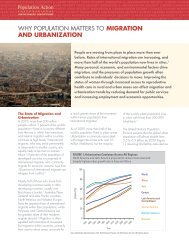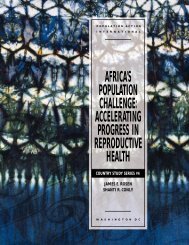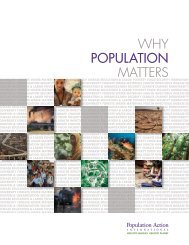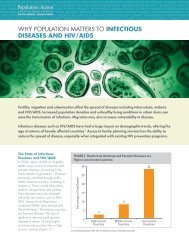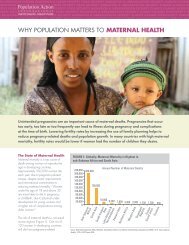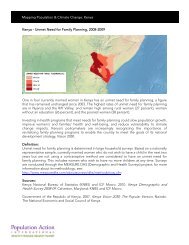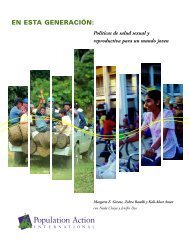Sustaining water, easing scarcity - Population Action International
Sustaining water, easing scarcity - Population Action International
Sustaining water, easing scarcity - Population Action International
Create successful ePaper yourself
Turn your PDF publications into a flip-book with our unique Google optimized e-Paper software.
volume of fresh <strong>water</strong> produced. And the overpumping<br />
of ground<strong>water</strong> has already led to dangerous<br />
increases in salinity as well as the rapid<br />
depletion of the aquifers themselves. 16<br />
This has led Namibia to launch a planning<br />
process aimed at extending its already massive network<br />
of supply pipelines to the Okavango River,<br />
which runs throughout the year along its northeastern<br />
border with Angola. The plan would divert<br />
an estimated 20 million cubic meters of <strong>water</strong><br />
from the river through the 155-mile pipeline.<br />
The problem is that the river flows into Botswana,<br />
where it feeds the largest delta—and one of the<br />
most delicate ecosystems—in the world. Moreover,<br />
at least 100,000 people living along the edges of the<br />
Okavango Delta depend on the <strong>water</strong> for survival. 17<br />
With its <strong>water</strong> needs expected to double within<br />
the next 20 years, 18 Namibia sees the pipeline<br />
as the only feasible solution to keep pace with the<br />
<strong>water</strong> demands of its growing urban centers.<br />
Botswana, on the other hand, contends that the<br />
diversion could damage the biologically diverse<br />
marshlands along the Okavango Delta, which is<br />
Botswana’s main tourist attraction, and dry up the<br />
floodplain along which most of the delta’s inhabitants<br />
live. 19 Hydrologists now predict that<br />
Windhoek, Namibia’s capital, could begin to<br />
run short of <strong>water</strong> in 1998. 20 Clearly, the need<br />
for both governments to negotiate a long-term<br />
solution is urgent.<br />
The Case of the<br />
Tigris-Euphrates Basin<br />
A situation with more serious international implications<br />
is the growing demand for the <strong>water</strong>s of<br />
the Euphrates River by Turkey, Syria and Iraq.<br />
Rising in Turkey and flowing south through Syria<br />
and Iraq into the Persian Gulf, the Euphrates is the<br />
primary <strong>water</strong> source for millions of people who<br />
depend on it for power generation and irrigation in<br />
an extremely arid climate. Although the conflict<br />
over <strong>water</strong> between these countries is decades old,<br />
it has intensified in recent years as a result of a<br />
massive Turkish dam building program known as<br />
the Greater Anatolia Project (GAP). Designed to<br />
provide a supply of <strong>water</strong> and power adequate to<br />
fuel the development needs of Turkey’s population,<br />
which is growing at 1.6 percent annually, GAP is<br />
one of the most massive <strong>water</strong> infrastructure projects<br />
in history. When completed, it will provide<br />
Turkey with a generating capacity of 7,500<br />
megawatts of electricity—nearly four times the<br />
capacity of Hoover Dam—and open at least 1.5<br />
million hectares of land to irrigated cultivation. 21<br />
Though GAP promises to bring prosperity to<br />
the estimated 7 million Turks who live in the<br />
region, Syria and Iraq have good reason to worry<br />
about the project’s impact on their <strong>water</strong> supplies.<br />
Full implementation of the GAP system of dams<br />
could result in a 40 percent reduction of the<br />
Euphrates’ flow into Syria and an 80 percent<br />
reduction of flow into Iraq. Such a scenario has<br />
the potential to reduce the electrical output of<br />
Syria’s Tabqa Dam, one of its primary power<br />
sources, to 12 percent of capacity, while Iraq could<br />
lose irrigation <strong>water</strong> to one million hectares, or<br />
approximately 20 percent of its total arable land.<br />
In addition, the reduction of the river’s flow and<br />
the development in Turkey that will be fueled by<br />
the project will increase the level of salinity as well<br />
as the amounts of agricultural and industrial pollution<br />
in the remaining <strong>water</strong>s that will be conveyed<br />
into Syria and Iraq. 22<br />
Both Syria and Iraq have already threatened<br />
war over their access to the Euphrates, heightening<br />
the urgency of a regional <strong>water</strong>-sharing agreement<br />
before the existing <strong>water</strong> shortages become<br />
even more acute. 23 As the populations of these<br />
nations continue to expand, driven by fertility<br />
rates well above the global average, the competition<br />
for fresh <strong>water</strong> between agriculture and development<br />
could engender increased instability in a<br />
region that is already dangerously unstable.<br />
9



